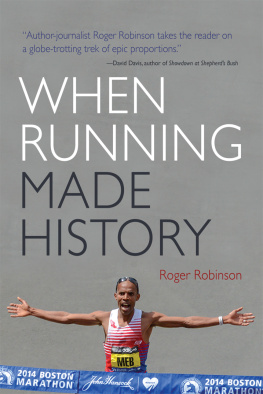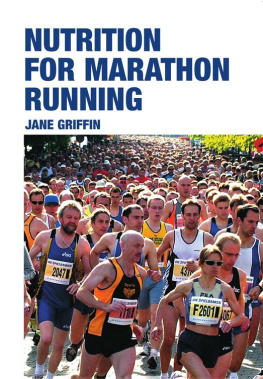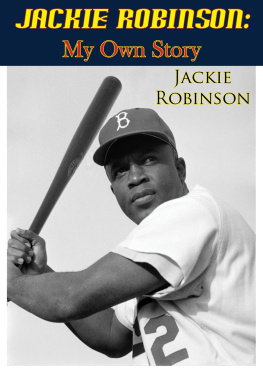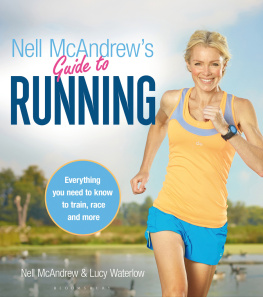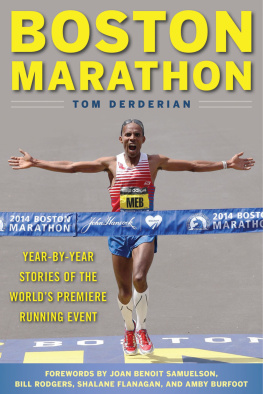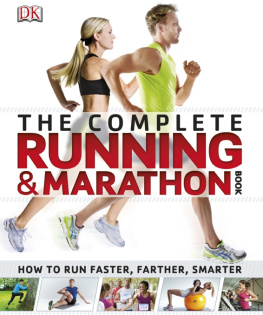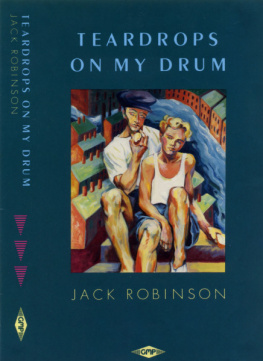Table of Contents
Guide
Page List
Select Titles in Sports and Entertainment
Abel Kiviat, National Champion: Twentieth-Century Track & Field and the Melting Pot
Alan S. Katchen
The American Marathon
Pamela Cooper
Anything for a T-Shirt: Fred Lebow and the New York City Marathon, the Worlds Greatest Footrace
Ron Rubin
The Fastest Kid on the Block: The Marty Glickman Story
Marty Glickman with Stan Isaacs
Legends Never Die: Athletes and Their Afterlives in Modern America
Richard Ian Kimball
The 1929 Bunion Derby: Johnny Salo and the Great Footrace across America
Charles B. Kastner
(Re)Presenting Wilma Rudolph
Rita Liberti and Maureen M. Smith
The War of the Wheels: H. G. Wells and the Bicycle
Jeremy Withers
Illustrations are from authors collection unless otherwise specified.
Copyright 2018 by Syracuse University Press
Syracuse, New York 13244-5290
All Rights Reserved
First Edition 2018
18 19 20 21 22 23 6 5 4 3 2 1
The paper used in this publication meets the minimum requirements of the American National Standard for Information SciencesPermanence of Paper for Printed Library Materials, ANSI Z39.48-1992.
For a listing of books published and distributed by Syracuse University Press, visit www.SyracuseUniversityPress.syr.edu.
ISBN: 978-0-8156-3578-9 (hardcover)
978-0-8156-1100-4 (paperback)
978-0-8156-5443-8 (e-book)
Library of Congress Cataloging-in-Publication Data
Names: Robinson, Roger, 1939author.
Title: When running made history / Roger Robinson.
Description: First edition. | Syracuse, New York : Syracuse University Press, [2018] | Series: Sports and entertainment | Includes bibliographical references and index.
Identifiers: LCCN 2018011324 (print) | LCCN 2018011601 (ebook) | ISBN 9780815654438 (E-book) | ISBN 9780815635789 (hardback : alk. paper) | ISBN 9780815611004 (pbk. : alk. paper)
Subjects: LCSH: RunningHistory.
Classification: LCC GV1061 (ebook) | LCC GV1061 .R54 2018 (print) | DDC 796.42dc23
LC record available at https://lccn.loc.gov/2018011324
Manufactured in the United States of America
FOR KATHRINE SWITZER
Rejoice, we conquer.
Illustrations
Acknowledgments
This book shows the influence of a lifetime of family, friends, colleagues, and mentors. I have named many of these people in the narratives, so I have not repeated them here. Most influential for the book itself are the magazine editors I have written for: Tim Chamberlain, Jonathan Beverly, Rich Benyo, and Scott Douglas most importantly, as well as Michael Jacques, Chris Gaskell, Marc Bloom, Gordon Bakoulis, Amby Burfoot, Sarah Lorge Butler, Jack Fleming, Christopher Young, and Michael Doyle.
To these I now add the judicious, supportive, and highly professional staff of Syracuse University Press, especially editor-in-chief Suzanne Guiod and series editor Steven Riess, who have provided constructive input and done much to alleviate the loneliness of the long-distance writer.
I am grateful to those who enabled me to be present at so many historic events: Hal Higdon (). In addition, I am grateful to all the races that have made me their guest as runner and/or speaker. Special thanks to Jack Taunton and the Vancouver Marathon and to Dave Cundy and the Canberra Marathon, because both changed my life in good ways; and to AIMS (Association of International Marathons and Distance Races) for the privilege of being keynote speaker in Prague to honor the memory of Emil Ztopek.
The world of running writers, historians, and commentators is like a floating faculty of scholars, and these chapters contain information or ideas willingly shared by international experts, including all the editors named above, plus Budd Coates, Gary Corbitt, David Davis, Tom Derderian, Mike Fanelli, Bob Fitzgerald, Peter Gambaccini, Jim Gerweck, Hal Higdon, Creigh Kelley, David Martin, David Monti, Walt Murphy, James OBrien, Larry Rawson, Toni Reavis, Mike Sandrock, Phil Stewart, Kathrine Switzer, Greg Vitiello, Ken Young, Alan Brookes, Dan Cumming, Rob Reid, Frank Stebner, Margaret Webb, Louise Wood, Richard Mayer, Len Johnson, Trevor Vincent, Pat Butcher, Myles Edwards, Ferdie Gilson, Hugh Jones, Peter Lovesey, Bruce Tulloh, Mel Watman, Lynn McConnell, Sam McLean, Barry Magee, and Jim Robinson.
I always learn from the friends I run with, most recently Norman Goluskin, Marty Krakower, and Dennis Moore (combined age for the four of us is 293 years, so plenty of wisdom). Special thanks to Russell Tregonning and Mark Aierstok, orthopedic surgeons of excellence; I owe it to their skill that Im even on my feet. My replaced knees are named Russell and Mark in their honor.
Sincere thanks to those who provided the photographs (in many cases as a generous gift) that make this a pleasing book visually. Their credits are listed alongside the images.
And, for many kinds of influence or support, thanks to Joan Barker, Mike Barnow and Adrienne Wald, John Barrington, David Bedford, James Boorsinn, Ian Boyd, Margaret and Geoff Buttner, Jeremy Commons, Peter and Janette Coughlan, Jack and Char Coughlin, Rob de Castella, Debra Dicandilo, Sarah Dukler, Jon Dunham, Mel Edwards, Thom Gilligan, Jay Glassman, Kay Q. Ince, Lisa Jackson, Ross and Sally Jackson, Tim Johnston, Deena Kastor, Bill Keeler, Paul Kennedy, Bob and Lynn Kopac, Wesley Korir, Wendell and Sheila Lafave, Billy Lamb, Grant McLean, Peter Middleton, Jimmy Moran, Paul Morten and Anna Smith, Gerald and Trudy Mould, Frank Murphy, Dave Oja, Gabrielle ORourke, Richard Owen and Gabrielle Ruben, Carol and Richard Parker, Joe Philpott, John Pitarresi, Les and Peggy Potapczyk, Rhonda Provost, Chris Risker, Peggy Robinson, T. J. Robinson, Tom Robinson, Bill Rodgers, Allison Roe, Alan Ruben, Julia Santos Solomon, Nikki Slade Robinson, Barry Spitz, Alan Stevens, Rudy Straub, Prue Taylor, Glenda Teasdale, Sue Tulloh, Horst von Bohlen, Jane Vitiello, Marty Wanless, Nick Willis, Richard Willis, and Edith Zuschmann.
As always, the deepest heartfelt thanks go to Kathrine Switzer, whose loving support, profound knowledge of our sport, and daily example of creative energy have been of the essence. To her, as we pass thirty years of marriage, this book of a lifetime in running is dedicated.
Introduction
When impoverished, war-shattered London struggled to put on the 1948 Olympic Games, and huge crowds chanted for the inspirational Emil Ztopek, hope was created for postwar recovery and the possibility of international friendship, despite the darkening shadow of the Cold War.
When Ethiopian Abebe Bikila ran serenely to Olympic marathon victory in 1960, barefoot on the ancient cobblestones of Rome, he heralded a new source of respect for a continent that had long been undervalued and exploited.
When 26,000 marathon runners lingered and hugged and wept for joy beneath the Brandenburg Gate in Berlin in 1990, they made a public affirmation of international goodwill that outshone the official fireworks for German reunification three nights later.
When Christchurch, New Zealand, was devastated by earthquake in February 2011, the first major public event staged in that sport-loving city was a track meet on a grass track, with Olympic medalists sharing the effort to revive the communitys morale.
When an American man in 2014 won the Boston Marathon for the first time in thirty-one years, one year after bombs devastated the finish area, that race became a symbol for redemption and strength. At a memorial service, President Barack Obama used marathon running as a metaphor for all that is best in American and world societyour human qualities of courage, resilience, and generous communal spiritbringing to world attention a connection of ideas that had long been familiar to runners.

